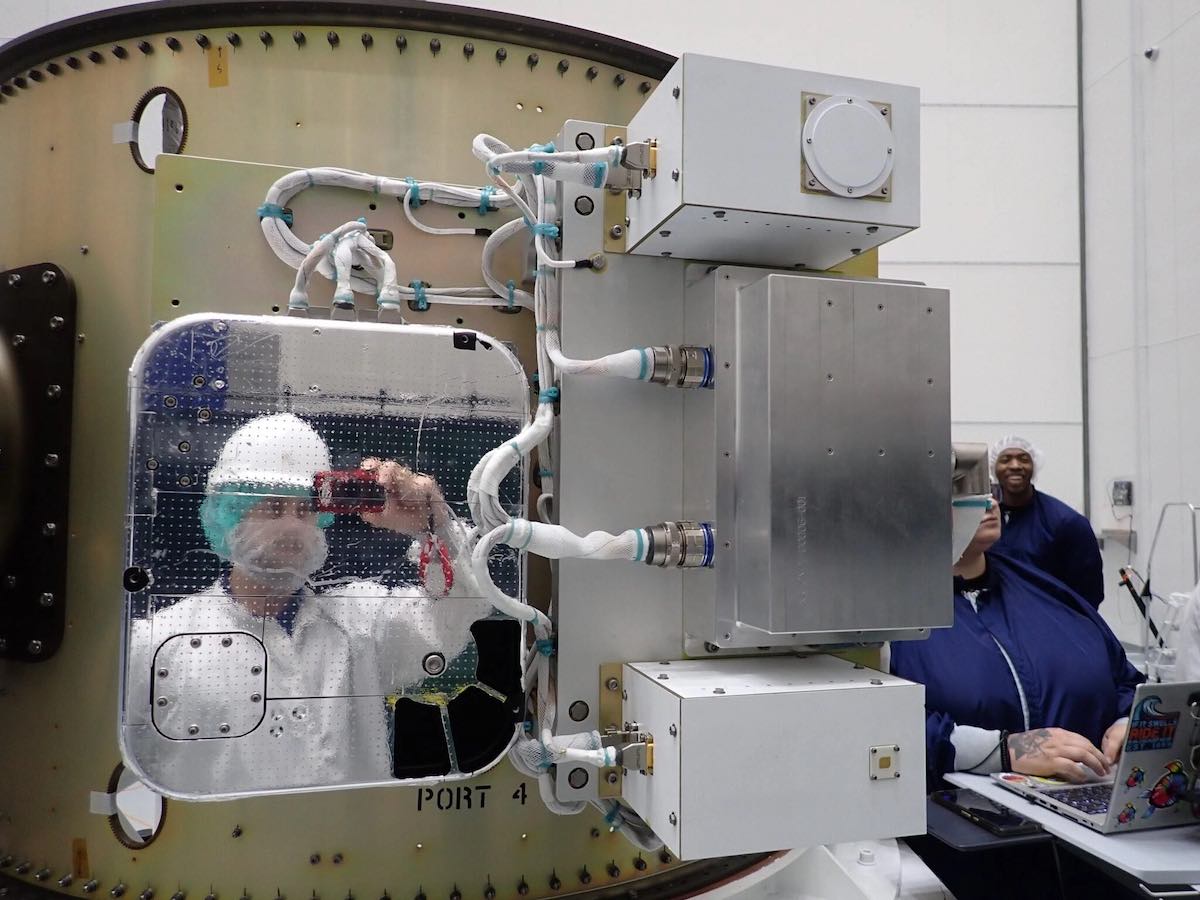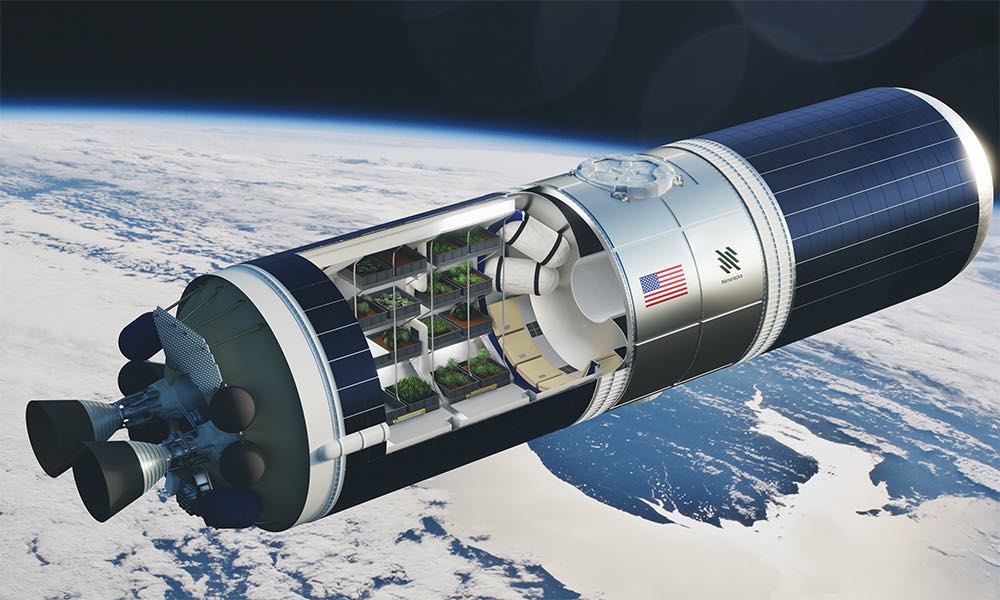Space News & Blog Articles
Nanoracks experiment poised to demonstrate metal cutting in orbit
 The Outpost Mars Demo-1 payload ready for launch on SpaceX’s Transporter 5 rideshare mission. Credit: Nanoracks
The Outpost Mars Demo-1 payload ready for launch on SpaceX’s Transporter 5 rideshare mission. Credit: Nanoracks
Nanoracks will fly an experiment with a small articulating robot arm on SpaceX’s Transporter 5 rideshare mission this week to demonstrate metal cutting in orbit, a test lasting just minutes that could advance in-space manufacturing technology to help convert used rocket stages into space habitats.
The Outpost Mars Demo-1 experiment is bolted to a stack of dozens of small satellites on top of a Falcon 9 rocket. Instead of deploying from the rocket to begin a standalone mission lasting months or years, the experiment will remain attached to the Falcon 9’s upper stage for a quick demonstration expected to run no more than 10 minutes.
“If you want to go into deep space, go to Mars, go to other places, we’ve got to start building and constructing vehicles in space rather than just launching them all lock, stock and barrel from the ground,” said Marshall Smith, senior vice president of space systems at Nanoracks. “So this is the first step toward that. Our eventual plan is to have multiple flights where we’re doing more welding, cutting, and demonstrating how do we do manufacturing in space — real honest to goodness manufacturing and building in space, rather than launching things pre-packed.”
Nine minutes after launch, as soon as the Falcon 9’s upper stage reaches orbit, the Outpost Mars Demo-1 experiment will begin. The payload is self-contained inside a box with a miniature robotic arm developed by Maxar Technologies, fitted with a friction milling end effector.
The technology demonstration is partially funded by NASA and managed by Nanoracks, with assistance from partners including Maxar and United Launch Alliance.
The on-orbit metal cutting experiment is part of the the Outpost program managed by Nanoracks, a company owned by Voyager Space. Nanoracks has developed a successful business helping companies, universities, and research institutions deliver their payloads to orbit. A big chunk of Nanoracks’ business is focused on providing commercial access to the International Space Station.
A next step for Nanoracks is the development of standalone platforms in orbit. Nanoracks, Voyager Space, and Lockheed Martin are partnering on the design of a commercial space station in low Earth orbit under a $160 million contract with NASA. The space agency in December also awarded similar design contracts to industry teams led by Blue Origin and Northrop Grumman, an early step in developing a replacement for the International Space Station.
NASA has an agreement with another company — Axiom Space — to add a commercial module to the International Space Station as soon as late 2024. Axiom is eyeing its own privately-owned space station.
Apart from its space station aspirations, Nanoracks says its Outpost program is aimed at transforming used launch vehicle upper stages into controllable platforms in Earth orbit.
“Imagine a future where Nanoracks-built hardware allows the empty fuel tank of any rocket to come back to life after its primary mission, but this time as a facility for robotic manufacturing, satellite servicing, a greenhouse, and more,” Nanoracks says on its website.
“Nobody has actually really done any significant metal work in space, so this will be the experiment where we’re going up, and we’re going to be cutting a metal piece,” Smith said in an interview. “It is the same material that’s used on the outer shell of a ULA Vulcan Centaur (rocket), and we’ll be cutting this piece without leaving any debris in the process.”
The Maxar cutting tool will run at high rotations per minute, melting the metal to create a cut. Thermal sensors and cameras will collect data and monitor the entire process.
There are three coupons of corrosion resistant steel on the Outpost Mars Demo-1 experiment.
“It’s a small coupon, we’re talking inches in size, and the point is to demonstrate the cut and make sure we can do it without getting any debris in the area,” Smith said.
If all goes according to plan the experiment will begin just after shutdown of the Falcon 9’s upper stage engine about nine minutes after launch from Cape Canaveral. The cutting demonstration should be finished around 10 minutes later, according to Voyager Space.
While the Falcon 9 continues its flight around the world to release nearly 40 small satellites, the Nanoracks experiment will remain bolted to the rocket, downlinking data and imagery to ground receiving stations. Within a couple of hours after launch, the Falcon 9 upper stage will fire its engine to de-orbit and re-enter the atmosphere, burning up with the Mars Demo-1 payload over the Pacific Ocean.
 Artist’s concept of a Nanoracks “Outpost” habitat derived from a salvaged rocket stage in orbit. Credit: Nanoracks
Artist’s concept of a Nanoracks “Outpost” habitat derived from a salvaged rocket stage in orbit. Credit: Nanoracks
The Transporter 5 mission is set for launch Wednesday from pad 40 at Cape Canaveral Space Force Station. A Falcon 9 rocket will target a polar orbit at an altitude of about 330 miles (530 kilometers).
The space station concept being designed by Nanoracks would launch as a single unit on a heavy-lift rocket. Meanwhile, Nanoracks is developing a system it calls a Mission Extension Kit, which could be integrated on any rocket’s upper stage, turning what would become space junk into a useful asset.
“That allows them, after they’ve done their primary mission, to continue operating almost indefinitely, doing other types of missions where the upper stage can be used for other opportunities — communications, debris monitoring, collecting debris, and those types of things,” Smith said.
The extension kits would provide power, pointing, data handling, and communications, allowing upper stages to be repurposed into habitable “outposts” after ending the launch portion of their missions.
“Eventually, what we’d like to have happen is be able to use upper stages to build more space station capabilities,” he said.
“Maxar’s innovative robotics engineering on Mars Demo-1 represents a critical step toward using new technology to reduce future space debris,” said Chris Johnson, Maxar’s senior vice president of space. “Maxar is excited to partner with Nanoracks on this demonstration, which will test new ways to keep space a safe place to operate and explore for future generations. We are committed to eliminating unnecessary debris while developing on-orbit servicing and manufacturing capabilities, technologies which will revolutionize the space industry.”
Nanoracks originally planned to launch the Outpost Mars Demo-1 experiment in late 2020. But the experiment has been reassigned to different SpaceX rideshare missions after delays caused by supplier issues and the COVID pandemic, according to Smith.
It would have been ready for SpaceX’s Transporter 4 mission, which launched April 1, but the payload manifest for that launch was fully booked. So it’s launching on Transporter 5, SpaceX’s fifth dedicated small satellite rideshare flight.
Nanoracks is designing follow-on experiments to Mars Demo-1, including a concept to harvest, cut, refine, and reuse metal from existing space junk, the company said on its website.
“This is an initial step,” Smith said. “There’s going to be quite a bit of work.”
This email address is being protected from spambots. You need JavaScript enabled to view it. the author.
Follow Stephen Clark on Twitter: @StephenClark1.
When you subscribe to the SpaceZE News Feed, we will send you an e-mail when there are new updates on the site so you wouldn't miss them.

